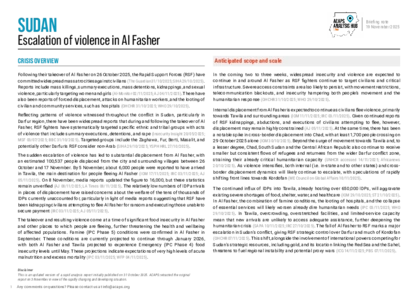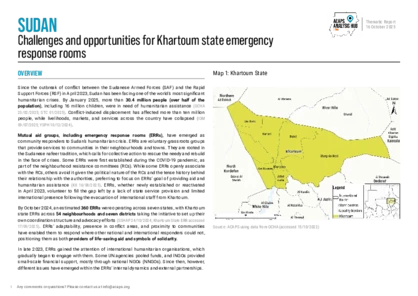Latest updates on country situation
09 December 2025
Drone strikes on 4 December 2025 hit multiple sites across South and North Kordofan, including a kindergarten in Kalogi, killing 96 people, including 43 children. Additional strikes hit a hospital treating the wounded and a food convoy, causing further casualties. Needs include trauma care, protection, and safe shelter. (PI 08/12/2025, AJ 07/12/2025)
04 November 2025
Famine (IPC Phase 5) is expected to persist in Al Fasher in North Darfur and Kadugli in South Kordofan from October 2025 to January 2026, according to the latest IPC analysis. Both areas have faced months of restricted humanitarian access, disrupted trade routes, and widespread market collapse. In Al Fasher, violence and repeated drone strikes trap hundreds of thousands of civilians, while in Kadugli, prolonged isolation has depleted food stocks and cut off supply lines. Nationally, 21.2 million people face Crisis (IPC Phase 3) or worse food insecurity, including more than 375,000 in Catastrophe (IPC Phase 5). The analysis highlights extensive livelihood disruption, high food prices, and limited humanitarian reach as key drivers. Malnutrition rates continue to rise sharply among children and pregnant or lactating women. The declaration underscores how prolonged sieges, economic deterioration, and conflict-driven displacement have eroded coping capacities, pushing entire urban populations towards starvation. (IPC 03/11/2025, AP 03/11/2025)
21 October 2025
Between 15–19 October 2025, at least 1,500 people fled Al Fasher town, North Darfur state, because of intensified fighting between the Sudanese Armed Forces and the Rapid Support Forces. Many among the displaced have moved towards Tawila town, where humanitarian conditions remain dire. The situation in and around Al Fasher remains volatile, raising concerns of worsening displacement and aid access. (IOM 20/10/2025, AA 20/10/2025)
14 October 2025
On 10 September 2025, shelling and drone strikes from the Rapid Support Forces killed at least 57 people, including 22 women and 17 children, and injured 21 others in Dar Al Arqam displacement centre in Al Fasher, North Darfur. The attack follows repeated strikes on civilian sites amid the current siege of the city, heightening protection risks. (PI 13/10/2025, UNICEF 12/10/2025, AJ 11/10/2025)
23 September 2025
On 19 September 2025, a drone strike on Al Safiya Mosque in Al Fasher, North Darfur, killed more than 70 civilians, including at least 11 children. The attack, attributed to the Rapid Support Forces, is among the deadliest since the city came under siege, further endangering civilians already facing famine, cholera, and restricted humanitarian access. (UN 19/09/2025, UNICEF 21/09/2025, BBC 19/09/2025)
16 September 2025
Heavy rains and floods on 12 September 2025 displaced about 4,300 people in Major 6 village, Um Algura locality, Al Jazirah. The impact includes the destruction of around 550 houses, with displaced families sheltering in open areas. The situation has compounded needs across the country, where communities already face conflict, displacement, and heightened disease risks. (IOM 14/09/2025)
16 September 2025
Sudan faces one of the world’s most severe education crises, with nearly 13 million of 17 million school-age children currently out of school given conflict and displacement since April 2023, which are also preventing around seven million enrolled children from attending. The other six million not enrolled at all risk permanent exclusion from education. As the new academic year began in September 2025, only 45% of schools had reopened. Among those remaining closed, 10% are sheltering displaced families. Teacher shortages, lack of materials, and restricted access continue to block learning opportunities. Flooding expected through October threatens to worsen the situation by destroying infrastructure and forcing further displacement. The prolonged lack of educational access places children at heightened risk of exploitation, early marriage, and armed group recruitment and perpetuates poverty cycles, posing critical long-term humanitarian challenges. (STC 11/09/2025, Jordan Times 11/09/2025, Al Arabiya 11/09/2025)
current crises
in
Sudan
These crises have been identified through the INFORM Severity Index, a tool for measuring and comparing the severity of humanitarian crises globally.
SDN001 - Complex crisis
Last updated 27/11/2025
Drivers
International Displacement
Conflict/ Violence
Political/economic crisis
Crisis level
Country
Severity level
4.7 Very High
Access constraints
5.0
Analysis products
on
Sudan
25 November 2025
Sudan: economic impacts and emerging trends in West and Central Darfur
DOCUMENT / PDF / 580 KB
This analysis focuses on West and Central Darfur as the dynamics of economic collapse are more acute and severe in these states than in other parts of the region. The report fills a critical gap by providing a targeted and in-depth examination of the specific economic impacts in these areas, including the neartotal breakdown of formal intra-Darfur and cross-border commercial systems.
19 November 2025
Sudan: scenarios (2026)
DOCUMENT / PDF / 1 MB
This report outlinines four scenarios that explore the ways governance and control in Sudan could develop until December 2026 and the potential impacts on people and the humanitarian response. The scenarios consider impacts on the economy, services, access, and humanitarian conditions.
19 November 2025
Sudan: escalation of violence in Al Fasher
DOCUMENT / PDF / 403 KB
Following their takeover of Al Fasher on 26 October 2025, the Rapid Support Forces (RSF) have committed widespread mass atrocities against civilians. Reports include mass killings, summary executions, mass detentions, kidnappings, and sexual violence, particularly targeting women and girls.
21 October 2025
Sudan: Food security and nutrition analysis - barriers, impacts, and opportunities
DOCUMENT / PDF / 325 KB
This report examines the challenges shaping food security and nutrition analysis in Sudan and how these constraints affect the production of reliable and consolidated evidence. The report considers the impact of these barriers on humanitarian response and identifies opportunities to strengthen collective analysis.
16 October 2025
Sudan: Challenges and opportunities for Khartoum state emergency response rooms
DOCUMENT / PDF / 358 KB
This report analyses the challenges and opportunities facing Emergency response rooms (ERRs)’ work in Khartoum state, as explained by ERR members and other national and international responders.






